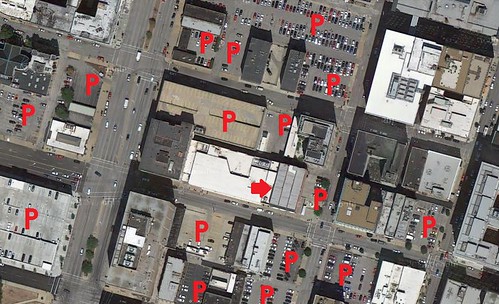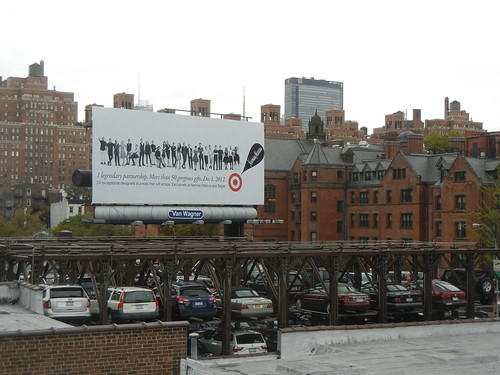by Michael R. Allen

Yesterday the St. Louis Preservation Board unanimously voted to withhold preliminary approval of Larry Deutsch’s plan to demolish the historic building at 1105-9 Olive Street and replace them with a surface parking lot. Deutsch’s attorney, former alderman and City Counselor Thomas Connelly, attempted to divert consideration of the ordinance criteria with unrelated arguments about the viability of downtown development, tenants’ demands for parking spaces and the loosely-documented structural condition of the building’s east wall.

Strangely, the testimony from Connelly’s packaged group of presenters did not include any testimony from a structural engineer, rendering the rhetoric about soundness just that. The Preservation Board renders decisions under a specific definition of soundness that states that a building must be able to stand for another six months. Clearly the building can do that. Alderman Craig Schmid, a member of the Board, very pointedly brought up the fact that the former owner was serving pizzas at Maurizio’s just six months ago, with a routine occupancy permit. That same owner just won a $1.3 million judgment against the builder of the adjacent underground parking structure, but abandoned 1105-9 Olive Street by not paying property taxes. The city’s cannot force that owner to use the windfall for anything at all, even unpaid taxes.
Deutsch’s main argument was not soundness, however, but the demands of tenants in his Laclede Gas Building at 11th and Olive. Supposedly the tenants want “adjacent” parking, and a lot across a street somehow is “adjacent.” As the map above shows, that is not a problem. Tenants — including one advertising firm owner who testified — already have found parking in one of the dozens of options around the building. The west side of Eleventh Street is a cornucopia of surface spaces, which are rarely ever full. (Skateboarders seem to know this.) Even if the spaces were full, they are not well-utilized — for instance, elevated lifts could be used to double or even triple the number of spaces available. The lack of lifts make sit clear that there is actually very low demand for parking spaces downtown, because the supply is so excessive.

The Preservation Board’s criteria for preliminary review of demolition include whether the replacement of a contributing building is a higher and better use. Randy Vines provided passionate testimony that made it clear that many who oppose this demolition might have varying views if a new building were proposed. Board member Anthony Robinson echoed that viewpoint, stating that he does not think 1105-9 Olive Street is a workable rehabilitation project but that a surface parking lot is a regressive use of the property.
The Preservation Board’s ruling is a much-needed statement as downtown development is picking up again. There are several small buildings, like those at 919 and 923 Locust Street, that sit empty and whose ability to qualify for historic rehabilitation tax credits might seem questionable at first glance. (Had only city leaders approved the proposed downtown National Register of Historic Places district nomination in 1978, these buildings would not face the wrecking ball today.) Other larger buildings, like the Alverne at 11th and Locust Street, have eluded developers’ grasp as well.
Whether the fates of these buildings is preservation or demolition will be determined in the next few years. The Preservation Board suggests that yanking them down for surface parking is not an option. Looks across the cracked asphalt ocean of Eleventh Street, that is welcome news. St. Louis has erased so much of its character to accommodate cars. Yet every surface lot has robbed the city of vitality, and downtown did not rebound until people started moving into its buildings. One decade into a new century, it is time that we realize that urban growth comes from human activity, and plan accordingly. The Board of Aldermen should consider passing a formal parking lot moratorium for downtown east of Tucker Boulevard, to ensure that the city’s heart is a place where real estate grows in value and grows in potential for use and benefit.

6 replies on “More Parking Lots in Downtown St. Louis: Unacceptable”
[…] Developers Continue to Plague Downtown With Unneeded Parking […]
[WORDPRESS HASHCASH] The comment’s server IP (64.90.55.210) doesn’t match the comment’s URL host IP (64.90.50.140) and so is spam.
People should call there aldermen member and demand a ordinance that a building in downtown east and west, midtown/ grand center and central west end. Can not be torn down for a parking lot or green space. Also add all new buildings must be in urban form.
Incredible the number of P’s for parking there are in the area. Maybe the city should eminent domain all of the lots and coordinate them so every little project doesn’t feel it needs it’s own parking. Private industry can’t do anything that is innovative it seems.
We need to be finished with auto only urban planning. It is no good for anyone except a few profiting from it. I agree with you a moratorium would be a good thing, but the city has to begin to consider the underlying problem of developing a desirable city, which means walkability, transit and bicycle friendly, not gutting the city for yet more parking.
Citywide historic preservation! when will we get there?
Michael, what do we know about the architectural history of this handsome building?
Very good analysis. Downtown St. Louis needs more foot traffic and density to generate the kind of energy that makes neighborhoods vibrant. “Dead” parking lots devitalize.